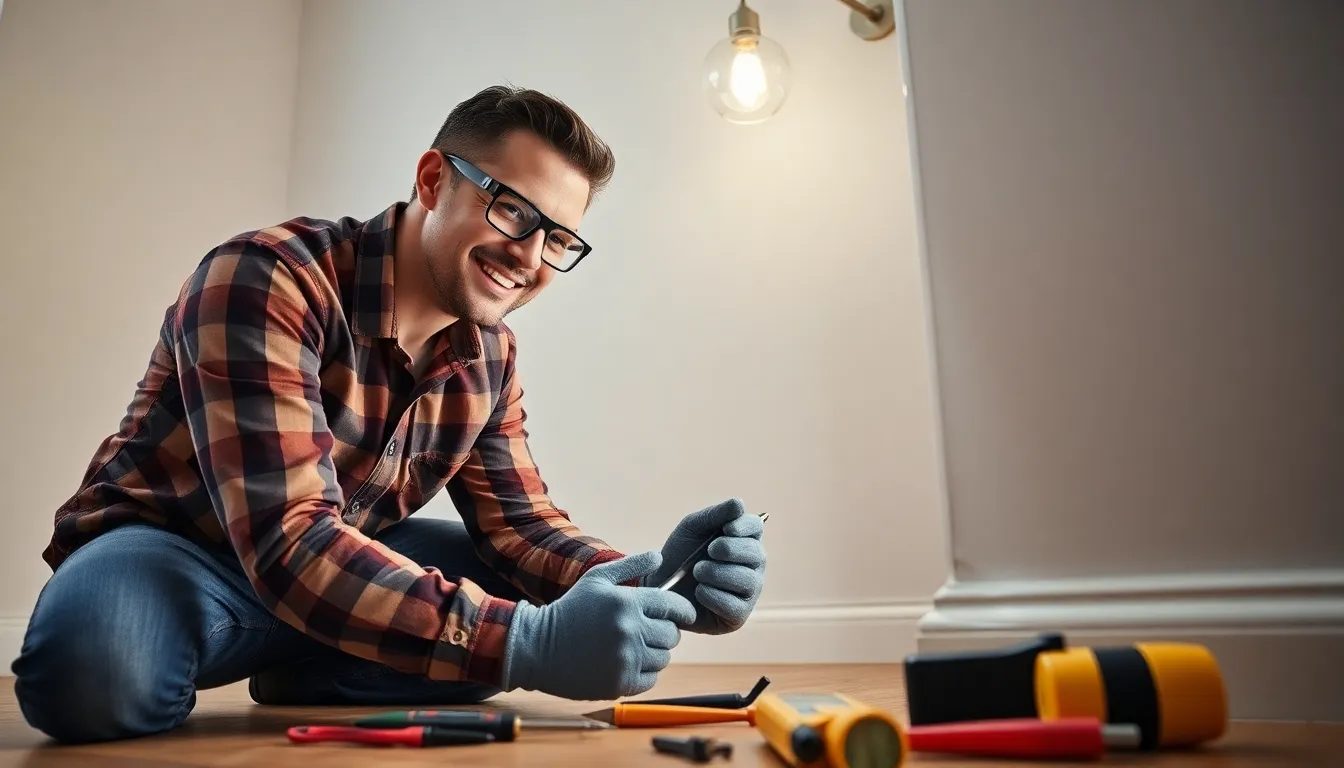Ready to unleash your inner electrician? DIY electrical projects can transform your home while giving you a sense of accomplishment that even the most seasoned pros envy. Imagine swapping out that outdated light fixture or wiring up a new outlet with nothing but your trusty toolbox and a dash of creativity. It’s like magic, but without the rabbit and top hat.
DIY Electrical Projects
DIY electrical projects empower homeowners to elevate their living spaces while gaining practical skills. Many simple tasks can transform a room. Replacing old light fixtures enhances visual appeal and energy efficiency. Installing new outlets increases functionality, adapting spaces to modern technology needs.
Safety remains the top priority in any electrical project. Individuals must understand basic electrical concepts before undertaking any task. Local building codes and regulations play crucial roles in determining what projects are permissible. Inspecting the workspace for any potential hazards ensures a smooth and secure working environment.
Common projects include installing dimmer switches, ceiling fans, and energy-efficient LED lighting. These updates not only create ambiance but also contribute to reducing energy costs. Homeowners can find numerous resources online, including instructional videos and step-by-step guides, enhancing their knowledge base.
Tools required for basic electrical work typically include a multimeter, wire stripper, screwdrivers, and a voltage tester. Familiarity with these tools empowers individuals to manage tasks effectively. Understanding wire types and colors is essential, as it helps in making correct connections and ensuring safety.
Planning each project promotes efficiency and clarity. Writing down steps, gathering materials in advance, and having a designated workspace contribute to a more organized approach. DIY electrical projects offer an opportunity for creativity and personal expression while adding value to homes.
Safety Precautions for DIY Electrical Work

Safety remains the main priority during DIY electrical projects. Using proper techniques and gear helps prevent injuries and accidents.
Essential Safety Gear
Wearing personal protective equipment offers essential protection. Safety goggles shield the eyes from flying debris. Nitrile gloves protect hands while handling wires. Non-slip shoes provide solid footing when working. A hard hat may be necessary for overhead projects. Each item contributes to a safer working environment.
Common Risks and How to Avoid Them
Electric shock ranks as the primary risk in electrical work. Turning off the circuit breaker before starting any project prevents potential hazards. Using a voltage tester verifies that wires are not live before touching them. Working in dry conditions minimizes the risk of electrocution. Ensuring tools are in good condition helps avoid accidents while cutting or stripping wires. Storing materials safely prevents trips and falls around the workspace.
Popular DIY Electrical Projects
DIY electrical projects offer homeowners the chance to upgrade their spaces while gaining valuable skills. Many popular projects cater to various needs.
Home Lighting Enhancements
Installing dimmer switches and energy-efficient LED bulbs transforms a room’s ambiance. Homeowners often find that these upgrades not only boost aesthetic appeal but also contribute to energy savings. Changing outdated light fixtures can refresh any space, adding personality and style. Using smart lighting systems allows for increased control over brightness and color, enhancing convenience. Such enhancements generally yield better environmental efficiency and create inviting atmospheres.
Simple Electrical Repairs
Performing simple electrical repairs can save homeowners money and time. Tasks like replacing broken switches or outlets are straightforward and utilize basic tools. Many individuals learn the skills to fix issues like flickering lights or tripped breakers. Following online guides and videos streamlines the process, ensuring effective results. Learning about wire types and connections significantly reduces the risk of errors. Such repairs foster confidence, allowing homeowners to tackle more complex tasks in the future.
Creating Custom Power Outlets
Custom power outlets cater to modern technology needs by improving functionality. Installing additional outlets in convenient locations facilitates charging devices easily. Homeowners can design multi-outlet strips or USB-integrated sockets for better access. Selecting materials that match existing decor creates a cohesive look throughout the space. Understanding electrical codes ensures installations comply with safety standards. Such projects enable homeowners to personalize their environments while addressing practical requirements.
Tools and Materials Needed
Having the right tools and materials ensures each DIY electrical project runs smoothly and safely. Understanding these essentials enhances overall effectiveness during various tasks.
Essential Tools for DIY Electrical Projects
A multimeter measures voltage, current, and resistance. It’s crucial for diagnosing electrical issues. Wire strippers precisely remove insulation from wires without damaging them. Screwdrivers, including flathead and Phillips, simplify securing and loosening connections. Pliers provide grip while manipulating wires, and a circuit tester confirms the absence of electrical current. Safety glasses and gloves protect against potential hazards. An electrical tape rolls easily around wires, offering insulation and protection. Lastly, a voltage tester helps identify live wires before starting any project.
Recommended Materials and Supplies
Wires come in various types, such as THHN or Romex, suitable for different applications. Junction boxes hold connections between wires securely. Outlets and switches cater to specific electrical needs, enabling customization for each project. Proper connectors, including wire nuts and crimp connectors, ensure secure connections. LED light bulbs provide energy efficiency, while dimmers control brightness for ambiance. Electrical tape seals connections, preventing short circuits and ensuring safety. Having a reliable circuit breaker ensures thorough protection against overloads. These materials combine to support various DIY projects effectively.
Step-by-Step Guide to a Sample Project
Installing a dimmer switch provides homeowners control over lighting levels and ambiance. Begin the project by gathering essential tools like a screwdriver, wire strippers, and a voltage tester. Always turn off power to the circuit at the breaker before starting any electrical work.
Next, remove the existing switch cover by using a screwdriver. After removing the cover, unscrew the existing switch from the electrical box. Be cautious with wire handling to avoid electrical shock. Identify which wires are connected to the existing switch.
Disconnect the old switch, noting its wiring configuration. Color codes typically indicate the function of each wire: black wires usually serve as hot wires, while white wires are neutral. Disconnecting these wires requires careful use of wire strippers to remove insulation without damaging the wire itself.
Connect the new dimmer switch. Attach the black wires from the switch to the black hot wire in the box. Similarly, connect the white neutral wire to the dimmer’s corresponding terminal. Ensure all connections are secure and use electrical tape to seal them as necessary.
Before replacing the cover, double-check all connections for security. Turn the circuit back on at the breaker and test the dimmer switch functionality. Adjust the dimming level to ensure everything operates as intended.
Finally, reattach the cover and clean up any debris. Completing this project not only enhances lighting efficiency but also provides a sense of accomplishment and improves the home’s overall aesthetic.
Conclusion
Embarking on DIY electrical projects not only transforms living spaces but also builds confidence and skills. With the right tools and safety precautions in place homeowners can tackle tasks that enhance both functionality and aesthetics. Each project completed serves as a testament to creativity and resourcefulness.
By exploring various electrical upgrades like dimmer switches and energy-efficient lighting homeowners can enjoy the satisfaction of personalizing their environment. As they delve into these projects they also contribute to energy savings and increased home value. The journey of DIY electrical work is filled with opportunities for learning and growth making it a worthwhile endeavor for anyone looking to improve their home.

